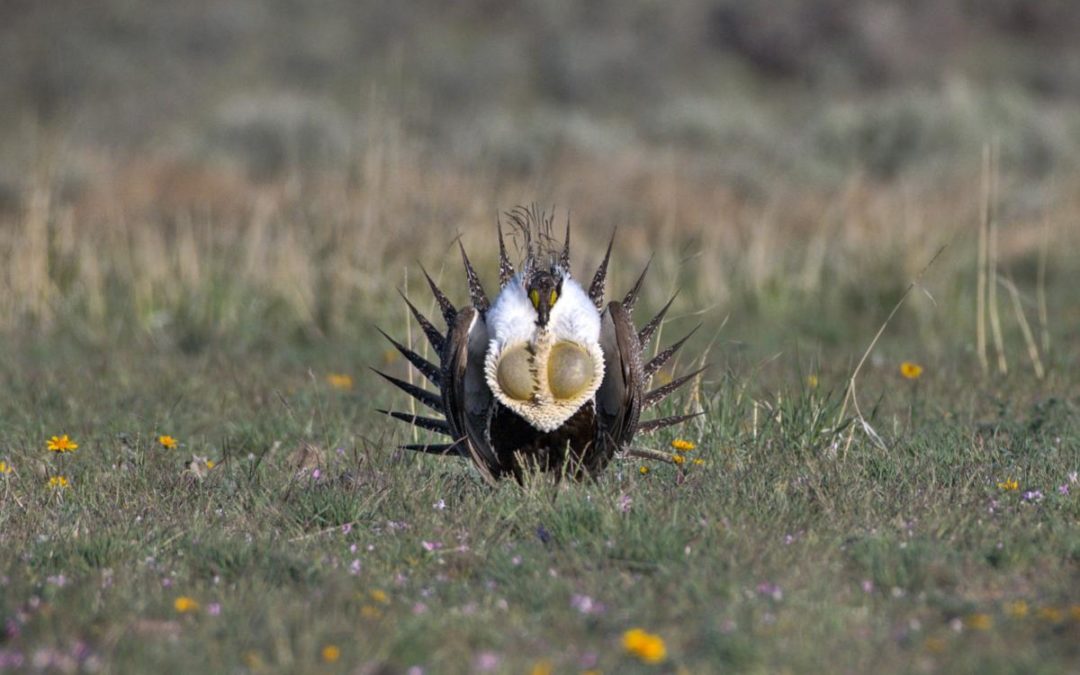SOURCE: Magic Valley News
DATE: June 17, 2020
SNIP: About a dozen birds fly in at about 4:30 a.m. from all directions, like a rag-tag squadron of chicken-sized helicopters.
It takes a minute for all the male grouse to arrive at the small clearing in the sagebrush. Their wings whoosh loudly in the pitch black, fluth-uth-uth-uth-uth-uth-th-th-th-t-t-t-t.
When the sage grouse land at the lek, their group breeding grounds, they start dancing. Until dawn, when the sun peaks over the snow-covered buttes and casts an orange glow over the sagebrush, you just hear this display, the bouncy, water-drop sound of the males inflating the air sacks on their chests, competing to attract females.
The spring mating ritual of this stocky, flamboyant bird is becoming increasingly rare. For the past 60 years sage grouse numbers have been declining steadily, but in the last handful of years populations across the bird’s western range have nosedived. Sage grouse numbers have always fluctuated, cyclically, but experts say that doesn’t account for the recent drops.
While leks like this one in southern Twin Falls County, accessible by rugged two-tracks and backdropped to the south by white mountains, are doing relatively well, even sage grouse in the Magic Valley have suffered big losses in the past few decades. Again and again, massive fires gobble up thousands of acres of critical sagebrush habitat.
According to Idaho Fish and Game, the state population, much of which is in the Magic Valley, dropped 52% between 2016 and 2019 — Fish and Game is still analyzing the 2020 lek count data, but Magic Valley Regional Wildlife Manager Mike McDonald said this year’s numbers are similar to 2019’s.
Experts say if protection efforts for sage grouse at the federal and state levels don’t improve, the bird faces a bleak future. Since 2016, the Trump administration has worked to roll back sage grouse protections at a time when scientists say the entire sagebrush ecosystem is under threat and the best available data suggest the bird needs more, not less, help to avoid extinction.
“There’s really no concrete evidence that they (federal agencies) are doing much other than some bureaucratic arm waving,” said Jack Connelly, a leading sage grouse expert who spent decades studying the bird as an Idaho Fish and Game biologist. “It’s pretty discouraging.”
In the past few decades, millions of acres of sagebrush have been lost to wildfire and much more habitat has been degraded by oil and gas mining, new infrastructure and other activities [ED NOTE: Cattle grazing]. Sage grouse are highly specialized to a life in sagebrush — they can’t live without it.
Just under 40% of remaining sage grouse habitat is in Wyoming, where the primary threat to the bird is energy production. In Idaho, another sage grouse stronghold with 14% of remaining sage grouse habitat, the bird mainly faces two, intertwined, threats: Wildfire and invasive species [ED NOTE: Caused by cattle grazing].
There are several factors that have led to massive increases in wildfires — humans, with greater access to public lands, are starting many more fires and climate change is playing a role — but non-native, invasive species like cheatgrass are the biggest contributing factor.
When a fire decimates sagebrush habitat, cheatgrass often springs out of the blackened ground first. The species outcompetes native plants and dries early in the year, turning into thousands of acres of fuel, which often burns once more, kickstarting the cycle anew.
Since 2015, the situation for sage grouse has only gotten worse. Thousands of new oil and gas wells have been permitted and huge amounts of additional sagebrush habitat have burned.
Sage grouse were close to being listed a decade ago, and state populations have already declined by 44% on average since then.
In order for recovery efforts to have a chance to succeed, Connelly said, agencies have to set policies grounded in objective, scientific data. But, he added, the BLM is not making decisions based on science, and the people calling the shots on sage grouse aren’t very knowledgeable.
Besides reducing protections, there are major problems surrounding many of the BLM’s ongoing efforts to help sage grouse, Connelly said.
For example, the BLM plans to build thousands of miles of new fuel breaks, to try and slow down wildfires. Many scientists say the program could do more harm than good. Fuel breaks typically involve new landscape disturbance and there isn’t much data to show they’re effective.
They have to be placed strategically, too, in order to avoid causing new harm to sage grouse habitat.

